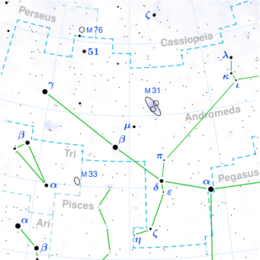Astronomy:Epsilon Andromedae
| Observation data Equinox J2000.0]] (ICRS) | |
|---|---|
| Constellation | Andromeda |
| Right ascension | 00h 38m 33.34610s[1] |
| Declination | +29° 18′ 42.3135″[1] |
| Apparent magnitude (V) | 4.357[2] |
| Characteristics | |
| Spectral type | G6 III Fe−3 CH1[3] |
| U−B color index | +0.463[2] |
| B−V color index | +0.8713[2] |
| V−R color index | +0.6[4] |
| R−I color index | +0.51[5] |
| Astrometry | |
| Radial velocity (Rv) | −84.43±0.15[6] km/s |
| Proper motion (μ) | RA: −229.04[1] mas/yr Dec.: −253.11[1] mas/yr |
| Parallax (π) | 19.91 ± 0.19[1] mas |
| Distance | 164 ± 2 ly (50.2 ± 0.5 pc) |
| Absolute magnitude (MV) | +0.69[7] |
| Details[6] | |
| Mass | 1.01±0.35 M☉ |
| Radius | 9.04±0.34 R☉ |
| Luminosity | 51.3 L☉ |
| Surface gravity (log g) | 2.88±0.02 cgs |
| Temperature | 5,082±20 K |
| Metallicity [Fe/H] | −0.53±0.05 dex |
| Rotational velocity (v sin i) | 1.70±0.45 km/s |
| Age | 5.71±5.29 Gyr |
| Other designations | |
| Database references | |
| SIMBAD | data |
Epsilon Andromedae, Latinized from ε Andromedae, is a star in the constellation of Andromeda.[4] It can be seen with the naked eye, having an apparent visual magnitude of 4.4.[2] Based upon an annual parallax shift of 21.04 mas as seen from Earth,[1] it is located 155 light years from the Sun. The system is moving closer to the Sun with a radial velocity of −84 km/s.[6] Its orbit in the Milky Way is highly eccentric, causing it to move rapidly relative to the Sun and its neighboring stars.[8]
Properties
This is an evolved G-type giant star with a stellar classification of G6 III Fe−3 CH1.[3] The suffix notation indicates there is a strong underabundance of iron in the spectrum, and an overabundance of cyanogen (CN). ε Andromedae is believed to be a red clump[9] star which is fusing helium in its core. It has about the same mass as the Sun, but has expanded to nine times the Sun's radius. The star is radiating 51 times the Sun's luminosity from its enlarged photosphere at an effective temperature of 5,082 K.[6]
Naming
In Chinese, 奎宿 (Kuí Sù), meaning Legs (asterism), refers to an asterism consisting of ε Andromedae, η Andromedae, 65 Piscium, ζ Andromedae, δ Andromedae, π Andromedae, ν Andromedae, μ Andromedae, β Andromedae, σ Piscium, τ Piscium, 91 Piscium, υ Piscium, φ Piscium, χ Piscium and ψ¹ Piscium. Consequently, the Chinese name for ε Andromedae itself is 奎宿四 (Kuí Sù sì, English: the Fourth Star of Legs.)[10]
References
- ↑ 1.0 1.1 1.2 1.3 1.4 1.5 van Leeuwen, F. (November 2007). "Validation of the new Hipparcos reduction". Astronomy and Astrophysics 474 (2): 653–664. doi:10.1051/0004-6361:20078357. Bibcode: 2007A&A...474..653V.
- ↑ 2.0 2.1 2.2 2.3 Jennens, P. A.; Helfer, H. L. (September 1975). "A new photometric metal abundance and luminosity calibration for field G and K giants.". Monthly Notices of the Royal Astronomical Society 172 (3): 667–679. doi:10.1093/mnras/172.3.667. Bibcode: 1975MNRAS.172..667J.
- ↑ 3.0 3.1 Keenan, Philip C.; McNeil, Raymond C. (1989). "The Perkins catalog of revised MK types for the cooler stars". Astrophysical Journal Supplement Series 71: 245. doi:10.1086/191373. Bibcode: 1989ApJS...71..245K.
- ↑ 4.0 4.1 4.2 "eps And". SIMBAD. Centre de données astronomiques de Strasbourg. http://simbad.u-strasbg.fr/simbad/sim-basic?Ident=eps+And.
- ↑ HR 163, database entry, The Bright Star Catalogue, 5th Revised Ed. (Preliminary Version), D. Hoffleit and W. H. Warren, Jr., CDS ID V/50. Accessed on line August 28, 2008.
- ↑ 6.0 6.1 6.2 6.3 Jofré, E.; Petrucci, R.; Saffe, C.; Saker, L.; de la Villarmois, E. Artur; Chavero, C.; Gómez, M.; Mauas, P. J. D. (2015). "Stellar parameters and chemical abundances of 223 evolved stars with and without planets". Astronomy & Astrophysics 574: A50. doi:10.1051/0004-6361/201424474. Bibcode: 2015A&A...574A..50J.
- ↑ Takeda, Yoichi et al. (August 2008). "Stellar Parameters and Elemental Abundances of Late-G Giants". Publications of the Astronomical Society of Japan 60 (4): 781–802. doi:10.1093/pasj/60.4.781. Bibcode: 2008PASJ...60..781T.
- ↑ Epsilon Andromedae , Stars, Jim Kaler. Accessed on line August 28, 2008.
- ↑ Puzeras, E. et al. (October 2010). "High-resolution spectroscopic study of red clump stars in the Galaxy: iron-group elements". Monthly Notices of the Royal Astronomical Society 408 (2): 1225–1232. doi:10.1111/j.1365-2966.2010.17195.x. Bibcode: 2010MNRAS.408.1225P.
- ↑ (in Chinese) AEEA (Activities of Exhibition and Education in Astronomy) 天文教育資訊網 2006 年 5 月 19 日
External links
Coordinates: ![]() 00h 38m 33.3458s, +29° 18′ 42.305″
00h 38m 33.3458s, +29° 18′ 42.305″
 |


